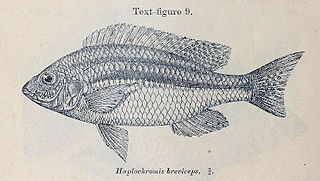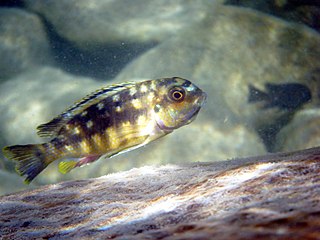Ethelwynn Trewavas was an ichthyologist at the British Museum of Natural History. She was known for her work on the families Cichlidae and Sciaenidae. She worked with Charles Tate Regan, another ichthyologist and taxonomist.

Protomelas is a genus of haplochromine cichlids endemic to Lake Malawi in East Africa. The genus is part of the haplochromine tribe and have maternal mouthbrooding and sexual dimorphism typical of this group. Popular in the aquarium hobby, Protomelas species are sold under a variety of trade names.

Oneirodidae, the dreamers are a family of marine ray-finned fishes belonging to the order Lophiiformes, the anglerfishes. These fishes are deepwater fishes found in the Atlantic, Indian and Pacific Oceans and it is the most diverse family of fishes in the bathypelagic zone.

Taeniolethrinops is a small genus of haplochromine cichlids endemic to Lake Malawi.

Buccochromis is a genus of relatively large haplochromine cichlids endemic to Lake Malawi and the upper Shire River in East Africa.

Otopharynx is a genus of haplochromine cichlids endemic to Lake Malawi in Eastern Africa.

Haplochromis is a ray-finned fish genus in the family Cichlidae. It has been used as the default "wastebin taxon" for Pseudocrenilabrinae cichlids of the East African Rift, and as such became the "largest" fish "genus". Many of these cichlids are popular aquarium fishes; like similar Haplochromini they are known as "haplos", "happies" or "haps" among aquarium enthusiasts.

Lethrinops is a genus of haplochromine cichlids endemic to Lake Malawi in East Africa. Particularly in the aquarium hobby, they are known as the sandeaters or sandsifters. Cichlid fishes of the Lethrinops genus have been studied in biology and ichthyology, primarily due to their radiated speciation and rapid evolution in their native habitat of Malawi. In biology, the speciation seen in these fish is known as explosive speciation. Numerous environmental pressures, such as overfishing, invasive species, and pollution threaten species of the Lethrinops genus. Malawi has established a national park to protect the cichlid species within the lakes.

Mylochromis is a genus of haplochromine cichlids endemic to Lake Malawi in Eastern Africa.

Nyassachromis is a genus of haplochromine cichlids endemic to Lake Malawi. They are open-water mouthbrooders, an ecological niche known as utaka to locals.

Tropheops is a genus of cichlids endemic to Lake Malawi.

Snaggletooths or stareaters are any of a number of small, deep-sea stomiid fish in the genus Astronesthes. They possess a bioluminescent red chin barbel that the fish use as a lure to attract small prey into striking distance.
Rhabdospora is a genus assigned to cells found in a variety of fish. First reported in 1892, there has since been disagreement over whether Rhabdospora represents a parasite of the phylum Apicomplexa or a specialized fish cell.
Eustomias is a genus of barbeled dragonfishes native to the oceanic depths of the Indian, Atlantic and Pacific oceans.
Leptostomias is a genus of barbeled dragonfishes.
Melanostomias is a genus of barbeled dragonfishes.
Photonectes is a genus of fish in the family Stomiidae found in Atlantic, Indian and Pacific Ocean.

Oneirodes is a genus of is a genus of marine ray-finned fish belonging to the family Oneirodidae, the dreamers, a family of deep sea anglerfishes. These predatory, deep-sea fishes are found around the world. This is the type genus, and the most speciose genus, of the family Oneirodidae. They are sexually dimorphic but, like most taxa within their family, the small males are free living and are not sexual parasites on the larger females. Only the females are used to identify the species in this genus as no species specific charaxcters have been found for males.
The large-eye snaggletooth, also called the straightline dragonfish or Antarctic snaggletooth, is a species of fish in the family Stomiidae.
Borostomias panamensis is a species of fish in the family Stomiidae. The species has been documented in the Pacific Ocean near Chile, and adults can reach a maximum length of ~30 centimeters.












